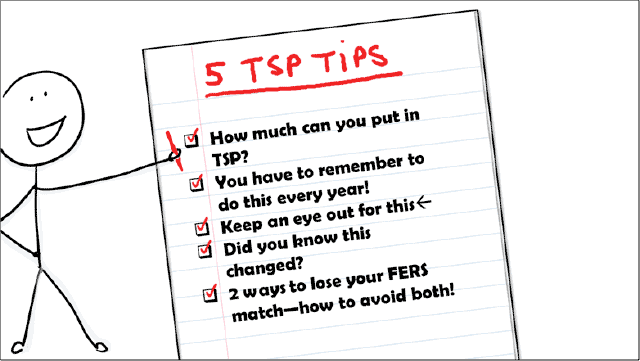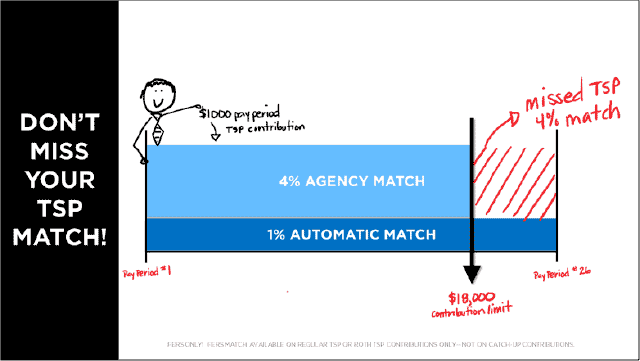What is TSP?
TSP stands for Thrift Savings Plan. It’s a retirement savings account a lot like a 401k. As a Federal employee, you can have money deducted from your paycheck and deposited into your TSP each pay period. Then when you retire, you can receive money each month from your TSP.
There are two ways you can save in your TSP: traditional TSP and Roth TSP. The only difference between them is WHEN you pay income taxes, everything else remains the same.
Traditional TSP
When you deposit money in traditional TSP, you don’t pay federal or state income taxes on that amount. It’s called tax deferred. However, when you take money from traditional TSP, it’s subject to federal and state income tax (depending upon the state where you live).
Roth TSP
The Roth TSP works the exact opposite! When you deposit money in Roth TSP, you do pay federal and state income taxes (depending upon the state where you live) on that amount. However, when you take money from the Roth TSP, it can be income tax free if you follow IRS rules.
Tip 1: How Much Can You Put In TSP?
Every year the IRS decides the maximum yearly amount that can be deposited into TSP. There are two types of deposits: Regular Contributions and Catch-Up Contributions. You can only make deposits into TSP through payroll deduction.
Regular Contributions
Regular Contributions are deposits you can begin making into TSP at any time while you’re working as an eligible Federal employee. You decide how much you want to deposit and it’s automatically deducted from your basic pay every pay period.
In 2017 the annual Regular Contribution limit is $18,000. You can make contributions in traditional TSP and/or Roth TSP. Contributions stop when you reach the annual limit.
Catch-Up Contributions
Catch-up contributions are extra deposits you can begin making into TSP any time starting in the year that you turn 50 years old as long as you expect to make the maximum Regular Contribution as an eligible Federal employee. This gives you the chance to save up more for your retirement. You decide how much you want to deposit and it’s automatically deducted from your basic pay every pay period.
In 2017 the annual Catch-Up Contribution limit is $6,000. You can make contributions in traditional TSP and/or Roth TSP. Contributions stop when you reach the yearly limit.
Tip 2: Catch-Up Contributions Don’t Carry Over From Year To Year
Catch-Up Contributions automatically stop when you reach the limit or when the calendar year ends—whichever comes first. They don’t continue from one year to the next.
You must make a new Catch-Up Contribution election each year.
Tip 3: Brainstorming More Ways
Finding ways to save more in TSP just makes good financial sense and retirement $$$!
Start with how much you are on track to save in 2017
To do this, you’ll need an up-to-date Leave & Earnings Statement, a pen and paper and a calculator (unless you like long-hand math!).
Add up your regular traditional TSP + Roth TSP deposits each pay period. Multiply that amount times 26 pay periods. That’s how much you’re depositing in 2017. Next, do the same steps if you’re making Catch-Up Contributions. (Please note that there is an occasional year in which there are 27 pay periods. Check with your payroll department to see when the next occurrence is for your agency.)
If you find that you’re not depositing the maximum you can, you’re probably not alone
Brainstorm at least 5 ways that you can deposit more into TSP in the next year. It can be a simple thing like skipping the expensive coffee in the morning and just bringing one from home! Periodically, increase your TSP contributions as you find ways to cut out unnecessary expenses.
TSP is designed to be a powerful benefit in retirement. Don’t skimp on your savings! Be on the lookout for more and more ways to increase your contributions! You’ll be glad you did when you retire.
Tip 4: This changed in 2006!
Back in the day, you could only deposit up to 15% of your basic pay into TSP. That was changed in 2006. You can now choose a percentage of your basic pay or a specific amount of money to deposit each pay period. This can be key to making the most of your TSP deposits because you can specify your contribution amount, instead of using a percentage.
Tip 5: Two ways to lose your TSP match—Avoid Both!
There’s a special benefit for FERS employees called the TSP Match. It’s extra money deposited in your TSP by the Federal government every pay period. The matching amount you get in TSP depends upon how much you’re depositing into your Regular Contribution (NOT Catch-Up Contribution).
Contribute at Least 5%
If you are a FERS employee depositing at least 5% to TSP each pay period, you’ll receive a 5% match. BUT if you’re depositing less than 5%, you’re missing out! Increase your TSP contributions to at least 5% as soon as you can afford to do so!
BUT You Can Put Too Much in TSP and lose the match…
The TSP Match is made of two parts: automatic 1% match and 4% agency match.
The automatic 1% match is just that—even if you’re not depositing anything into TSP, you’re receiving 1% of your basic pay deposited into TSP by the Federal Government at no cost to you.
The 4% agency match is added to TSP if you’re contributing 5% EACH pay period of the year.
Here’s where the snag can happen:
When you reach the maximum Regular Contribution Limit ($18,000), your contributions stop. If your contributions stop, then so does your 4% agency match!
Let’s say Sam Sample decides to deposit $1,000 per pay period into TSP. In pay period 18, Sam reaches the contribution limit of $18,000. His TSP contributions stop, and his 4% agency match stops, too.
Now is the time to look carefully for ways that you can make the most of your TSP in 2017 (plus correct any mistakes). TSP is a long-term savings program, and small changes now can add up to big results in your future!
Be sure to get your free companion guide, The TSP Check Up, to help plan your retirement.




